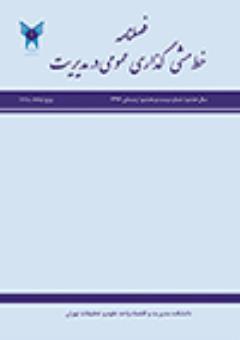مدل خطمشیگذاری عمومی مبتنی بر رویکرد اقتصاد رفتاری با روش فراترکیب
محورهای موضوعی : خطمشیگذاری عمومی در مدیریتمحمد فدایی 1 * , عباس نرگسیان 2
1 - دانشگاه تهران
2 - استادیار و عضو هیأت علمی دانشگاه تهران
کلید واژه: خطمشیگذاری عمومی, شکست خطمشی, اقتصاد رفتاری, رویکرد میانرشتهای, فراترکیب,
چکیده مقاله :
رویکردهای میانرشتهای یکی از روشهای موفق حل مسائل مزمن و قدیمی در رشتههای علمی در سالهای اخیر بوده است. دولتها در دوران مدرن از طریق خطمشیگذاری عمومی با مسائل جامعه مواجه و برای حل آن تلاش میکنند. میزان تحقق خطمشیهای عمومی معرف میزان موفقیت دولت در پیشبرد اهداف خویش و حل مسائل جامعه است. از طرف دیگر شکست خطمشیگذار بهمعنای شکست خطمشی عمومی است. کاهش نرخ شکست خطمشی مسئله پژوهش پیشرو است. بدین منظور از کاربست رویکرد اقتصاد رفتاری در خطمشیگذاری عمومی استفاده شده است. اقتصاد رفتاری با توصیف و پیشبینی رفتار بازیگران و ذینفعان کلیدی خطمشی امکان ارتقاء کیفیت خطمشی را فراهم میآورد. از این روی و باتوجه پژوهشهای موجود در این حوزه روش فراترکیب در دستورکار قرار گرفت. در نهایت با انتخاب و تحلیل نظاممند 20 پژوهش معتبر و مرتبط از حدود 100 پژوهش مرتبط اولیه، مدلی چهار مرحلهای برای تدوین خطمشیهای عمومی و فهرستی از 17 مؤلفه رفتاری مؤثر شامل اثر تأیید اجتماعی، اثر لنگر، اثر فریبگر، اثر مرجع پیام، اثر هیجانات، اثر مالکیت، اثر عزتنفس، اثر تعهد، اثر رفتار منصفانه، اثر تنزیل هذلولی، اثر وبر-و یشنر، معماری انتخاب، تلنگر، هدایت ضمنی، قاعده مبنا، اثر قاببندی و مشوقها به تفکیک هر مرحله در فرایند خطمشیگذاری عمومی بدست آمد.
Interdisciplinary approaches have been one of the successful methods of solving chronic and old problems in scientific fields in recent years. Governments in the modern era face society's problems through public policy and try to solve them. The level of realization of public policies is indicative of the government's success in advancing its goals and solving society's problems. On the other hand, the failure of the policy maker means the failure of the public policy. Reducing policy failure rate is a leading research issue. For this purpose, the application of the behavioral economics approach has been used in public policy making. By describing and predicting the behavior of policy actors and key stakeholders, behavioral economics provides the possibility of improving policy quality. Therefore, according to the existing researches in this field, the meta combination method was put on the agenda. Finally, with the systematic selection and analysis of 20 valid and relevant researches from about 100 primary relevant researches, a four-step model for formulating public policies and a list of 17 effective behavioral components were obtained separately for each stage in the public policy process.

